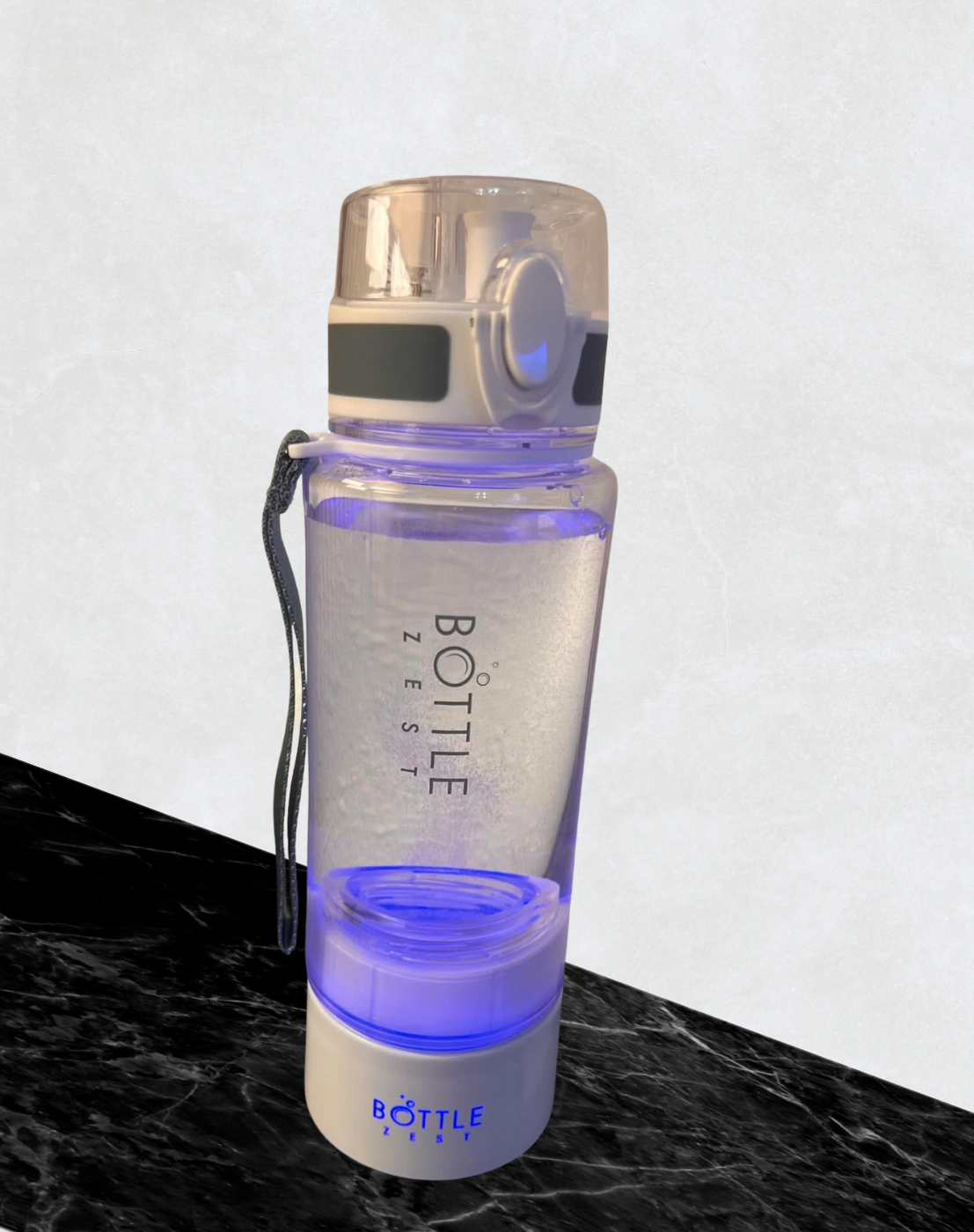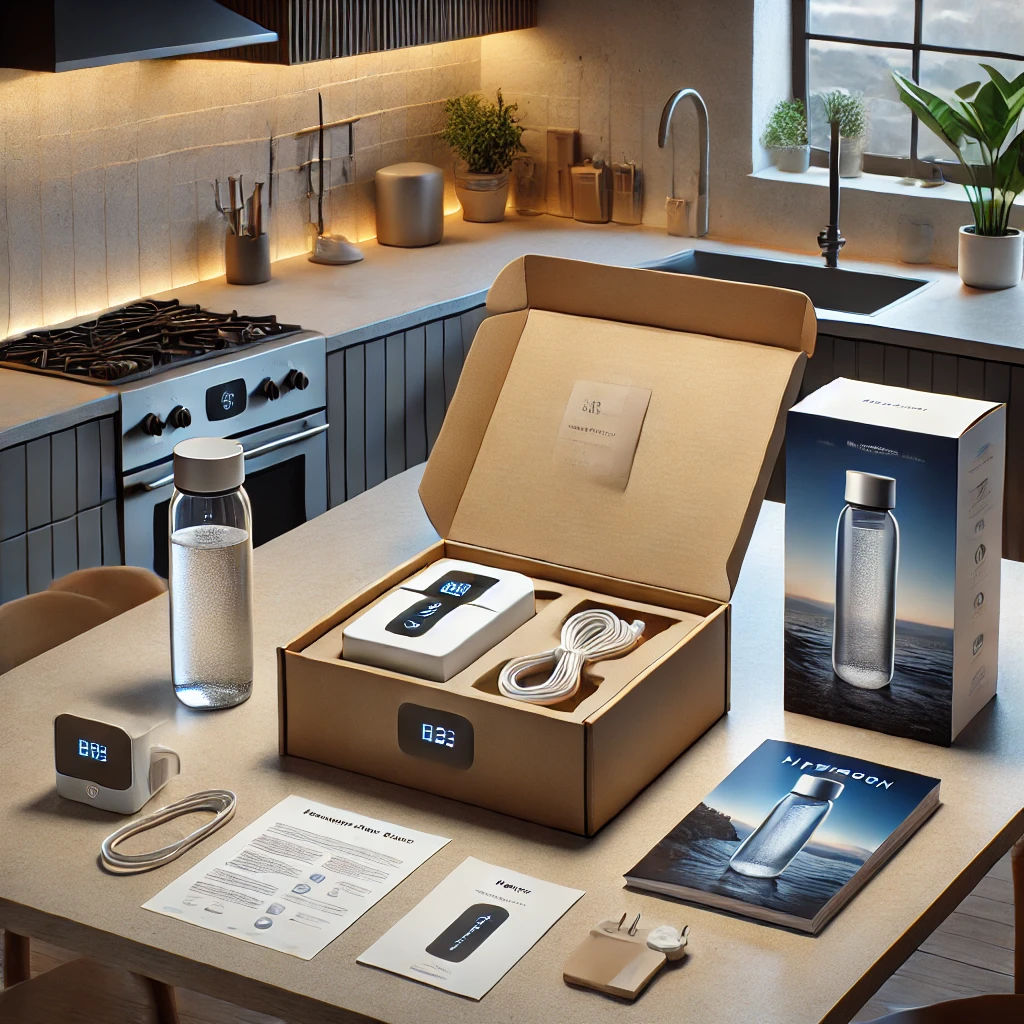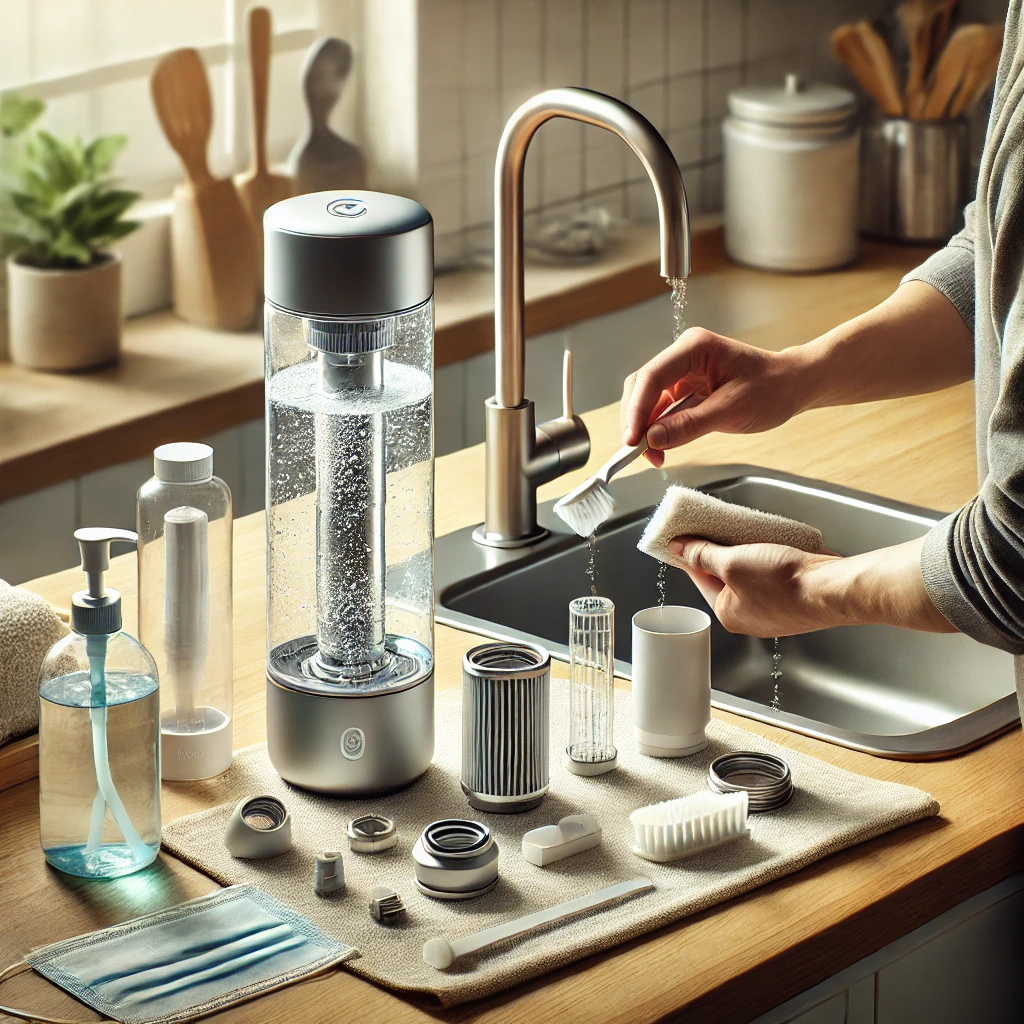How To Use Hydrogen Water Bottle?
A hydrogen water bottle infuses regular water with molecular hydrogen (H₂) through electrolysis, potentially offering health benefits like reduced inflammation and improved well-being. Portable and easy to use, these bottles are designed for daily hydration.

Correct use is essential for safety and effectiveness. Following guidelines ensures optimal hydrogen levels, prevents issues, and allows you to fully enjoy the health benefits of hydrogen water.
If you’re short on time, here’s the fast guide for you:
Step 1: Charging the Bottle (If Applicable)
Step 2: Filling the Bottle with Water
Step 3: Activating the Hydrogen Generation Process
Step 4: How to Know When the Water Is Ready to Drink
Step 5: Optimal Drinking Time and Frequency
Unboxing and Initial Setup
This preparation process helps you to ensure that your hydrogen water bottle is set up correctly and ready for use. Proper unboxing and initial setup are essential for optimal performance and longevity of your hydrogen water bottle.

What to Expect in the Box
When you receive your hydrogen water bottle, the first step is to unbox it and check the components. The typical package includes:
- Hydrogen Water Bottle: The main unit where the hydrogen generation occurs.
- Charger: A USB charger or charging cable is used to power the bottle.
- User Manual: A booklet or leaflet providing instructions for setup and use.
- Spare Parts: These may include extra O-rings, a detachable mouthpiece, or a base unit.
Each component plays a crucial role in ensuring that the hydrogen water bottle functions properly. The bottle itself is designed to contain water and facilitate the electrolysis process. The charger is essential for powering hydrogen generation, especially if the bottle is rechargeable. The user manual provides detailed instructions on how to use and maintain the bottle, and the spare parts are there to replace any worn-out components, ensuring longevity.
Charging the Hydrogen Water Bottle (If Applicable)
If your hydrogen water bottle is rechargeable, the next step is to charge it before use. Follow these steps:
- Connect the Charger: Plug the charger into the designated port on the bottle. Ensure it is securely connected to avoid any interruptions in charging.
- Power Source: Plug the other end of the charger into a power source. This could be a wall outlet or a USB port on your computer.
- Observe Charging Indicators: Most hydrogen water bottles have LED lights that indicate the charging status. A red light usually means it is charging, and a green light indicates a full charge. Some models may have additional indicators or sound alerts to inform you when the bottle is fully charged.
- Charging Time: Typically, it takes about 2-3 hours to fully charge a hydrogen water bottle. Ensure the bottle is fully charged before proceeding to use it for the first time.
Assembling Any Detachable Parts
After charging, you may need to assemble any detachable parts. This process is straightforward:
- Identify Detachable Parts: Refer to the user manual to identify any removable parts like the mouthpiece or base unit.
- Attach the Mouthpiece: If your bottle has a detachable mouthpiece, align it with the opening at the top of the bottle and twist it securely into place.
- Secure the Base Unit: Some bottles come with a detachable base that houses the battery or filtration system. Attach the base by aligning it with the bottom of the bottle and twisting or snapping it into place.
Ensure that all parts are firmly attached to prevent leaks or malfunctions during use.
Initial Cleaning Before First Use
Before using your hydrogen water bottle for the first time, it is essential to clean it thoroughly:
- Disassemble the Bottle: If the bottle has detachable parts, remove them and set them aside for separate cleaning.
- Use Mild Soap and Water: Fill the bottle with warm water and add a small amount of mild soap. Avoid using harsh detergents that could leave residues.
- Scrub Gently: Use a soft brush or sponge to clean the interior of the bottle, focusing on areas where water might come into contact. Pay special attention to the mouthpiece and base unit.
- Rinse Thoroughly: Rinse the bottle and all detachable parts with clean water to remove any soap residues.
- Dry Completely: Allow all components to air dry completely before reassembling. This step is crucial to prevent any residual moisture from affecting the hydrogen generation process.
Cleaning the bottle before first use removes any manufacturing residues, ensuring that your hydrogen water is pure and safe to drink.
Step-by-step Guide on How to Use Hydrogen Water Bottle
Step 1: Charging the Bottle (If Applicable)
Before using your hydrogen water bottle, ensure it is fully charged. This is vital for the proper generation of hydrogen. Here’s how to do it:
- Connect the Charger: Insert the charging cable into the designated port on the bottle. Ensure the connection is secure.
- Plug into a Power Source: Connect the other end of the charger to a power outlet or USB port.
- Monitor Charging Indicators: Most bottles feature LED lights to indicate charging status. Typically, a red light signifies that the bottle is charging, while a green light indicates that it is fully charged.
- Allow Full Charging Time: It usually takes about 2-3 hours for a complete charge. Make sure the bottle is fully charged before its first use.
Proper charging ensures the efficient functioning of the hydrogen generation process.
Step 2: Filling the Bottle with Water
Choosing the right water type is crucial for optimal hydrogen production. Follow these steps:
- Select the Right Water: Use filtered, distilled, or clean tap water. Avoid mineral-rich or hard water, as it may hinder hydrogen generation.
- Fill the Bottle: Open the bottle’s lid and pour water into it, leaving some space at the top. Overfilling can reduce the efficiency of hydrogen production.
- Secure the Lid: After filling, tightly close the lid to prevent leaks during the hydrogenation process.
Using the correct water type not only enhances hydrogen generation but also prolongs the lifespan of your bottle.
Step 3: Activating the Hydrogen Generation Process
Now that the bottle is filled, it’s time to activate the hydrogen generator:
- Press the Activation Button: Most bottles have a button that starts the hydrogenation process. Press it once to begin.
- Observe the Mode: Some bottles offer different hydrogenation modes, such as quick or deep hydrogenation. Choose the mode based on your preference. Refer to the user manual for specific mode details.
- Monitor the Process: Once activated, the bottle will begin generating hydrogen. This is usually indicated by bubbling or a specific light signal.
Activating the hydrogen generator is simple but crucial for producing hydrogen-rich water.
Step 4: How to Know When the Water Is Ready to Drink
After activation, it’s important to know when your hydrogen water is ready for consumption:
- Look for Indicators: Most bottles have LED lights or sound alerts that indicate when the water is fully hydrogenated. Typically, the light will change color, or a sound will signal completion.
- Check the Time: The hydrogenation process usually takes around 3-5 minutes, depending on the bottle and mode selected.
- Confirm Readiness: Ensure all indicators suggest that the process is complete before drinking.
Drinking water before the process completes may reduce the potential benefits.
Step 5: Optimal Drinking Time and Frequency
To maximize the benefits of hydrogen water, follow these guidelines:
- Best Times to Drink: Consume hydrogen water in the morning or after workouts for optimal hydration and energy.
- Daily Intake: While the exact amount can vary, a general recommendation is to drink 1-2 bottles per day.
- Frequency: Spread out your intake throughout the day to maintain consistent hydrogen levels in your body.
Following these guidelines will help you get the most out of your hydrogen water bottle.
Maintenance Tips
Cleaning and Sanitizing the Bottle
Daily Cleaning:
- Rinse After Each Use: Empty the bottle after use and rinse it with warm water. This prevents residue buildup and maintains water quality.
- Mild Soap and Soft Brush: Once a day, use mild soap and a soft brush to clean the inside of the bottle. Focus on areas that come into contact with water. Avoid using abrasive sponges as they may scratch the surface.

Weekly Deep Cleaning:
- Vinegar Solution: Once a week, fill the bottle with a solution of 1 part vinegar to 3 parts water. Let it sit for 15-20 minutes, then scrub with a soft brush and rinse thoroughly. This helps in removing any mineral deposits or bacteria that regular rinsing might miss.
- Rinse and Dry: After deep cleaning, rinse the bottle thoroughly to remove any vinegar residue, and allow it to air dry completely.
Replacing Filters or Cartridges (If Applicable)
If your hydrogen water bottle uses filters or cartridges, replacing them at the right time is crucial for maintaining water quality. Here’s how to manage this:
Identifying Replacement Needs:
- Check for Decreased Performance: If the hydrogen generation process seems slower or the water tastes different, it may be time to replace the filter or cartridge.
- Follow Manufacturer’s Recommendations: Most manufacturers provide a timeline for when to replace these components. Typically, filters should be replaced every 2-3 months, depending on usage.
Step-by-Step Replacement:
- Disassemble the Bottle: Unscrew the parts where the filter or cartridge is housed.
- Remove the Old Filter: Carefully remove the old filter or cartridge and dispose of it according to the manufacturer’s instructions.
- Install the New Filter: Insert the new filter or cartridge into the designated spot. Ensure it is securely fitted.
- Reassemble the Bottle: Screw the parts back together and run a full cycle with water to ensure everything is working correctly.
Storing the Bottle Properly
Choose the Right Storage Environment:
- Dry and Cool Place: Store the bottle in a dry, cool place away from direct sunlight. Excessive heat or moisture can damage the bottle’s components.
- Avoid Humid Areas: Storing the bottle in a humid environment can lead to mold growth or deterioration of the material.
Precautions to Prevent Damage:
- Empty the Bottle: Always empty the bottle of any remaining water before storage. Standing water can lead to bacteria growth or damage the bottle’s internal components.
- Store Upright: Store the bottle upright to prevent any residual moisture from causing leaks or damage.
Safety Precautions
Potential Side Effects of Excessive Hydrogen Water Consumption
Dizziness: Consuming too much hydrogen water can sometimes lead to dizziness. This is due to an imbalance in the body’s natural hydrogen levels. If you experience dizziness, reduce your intake and monitor your symptoms.
Nausea: Overconsumption might cause nausea. This is a common reaction when the body is adjusting to higher hydrogen levels. Gradually increasing your intake can help minimize this effect.
Gastrointestinal Discomfort: Some users report mild gastrointestinal discomfort after drinking large quantities of hydrogen water. This could manifest as bloating or gas. To avoid this, start with smaller amounts and increase gradually.

Guidelines for Moderate Consumption
To avoid these side effects, it’s crucial to consume hydrogen water in moderation:
- Start Small: Begin with a small amount, such as half a bottle a day, to allow your body to adjust.
- Monitor Your Body’s Reaction: Pay attention to how your body responds, and adjust your intake accordingly. If you experience any discomfort, reduce the quantity.
- Follow Manufacturer’s Recommendations: Adhere to the recommended daily intake provided by the manufacturer, typically around 1-2 bottles per day. This ensures you receive the benefits without overconsumption.
Recommendations for Specific Groups
Pregnant Women: Pregnancy alters a woman’s body in many ways, making it essential to consult with a healthcare provider before adding hydrogen water to your routine. While there is no widespread evidence suggesting harm, it’s better to err on the side of caution.
Children: Children’s bodies are more sensitive to changes, including dietary intake. If considering hydrogen water for children, consult a pediatrician first to ensure it’s appropriate for their age and health condition.
Individuals with Specific Health Conditions: If you have underlying health conditions such as gastrointestinal disorders or chronic illnesses, consult your healthcare provider before consuming hydrogen water. They can advise on the correct dosage or whether it’s safe for you to include in your daily routine.

Consulting a Healthcare Provider
Before introducing hydrogen water into your daily routine, especially if you belong to one of the groups mentioned above, consult with your healthcare provider. They can provide personalized advice based on your health history and current condition.
Conclusion
To get the most out of your hydrogen water bottle, follow the steps for proper use, regular maintenance, and mindful consumption. Charge the bottle fully, use the right water, and maintain a consistent cleaning routine. Be aware of potential side effects and consult a healthcare provider if you belong to a sensitive group.
Choosing a quality hydrogen water bottle is essential for safety and effectiveness. Visit our main website to explore top-rated hydrogen water bottles and find the right one for you.
FAQs
- What is the lifespan of a hydrogen water bottle?
A hydrogen water bottle typically lasts 1 to 3 years with proper maintenance.
- How often should I replace the filter?
Filters should be replaced every 2-3 months, depending on usage and manufacturer guidelines.
- Can I use tap water with the hydrogen water bottle?
Yes, but using filtered or distilled water is recommended for better performance.
- Is hydrogen water safe for children?
Generally, yes, but consult a pediatrician before use, especially for younger children.
- How long does it take for the bottle to charge?
Charging usually takes 2-3 hours, with LED indicators showing when it’s ready.
